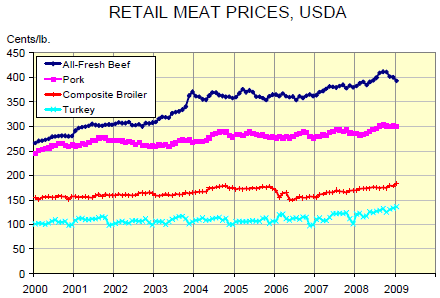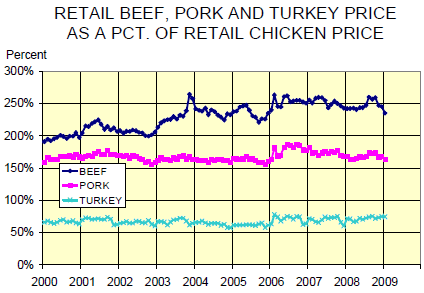



CME: Record High Broiler Prices in January
US - CME's Daily Livestock Report for 24 February 2009.CME has been saying for some time that US retail meat and poultry prices had to eventually rise in order to generate enough income at the retail and foodservice level to pull producer level demand up and compensate growers for higher costs. That entire process is in some jeopardy now as consumer incomes and wealth levels fall and consumers begin to deal with much tighter family budget situations. USDA’s retail price data for January indicated a bit of a mixed bag for average retail prices but the pattern still fits our expectations: Higher retail meat and poultry prices in 2009 led by poultry.
Poultry’s leadership position in this matter is driven by two factors. First, chicken is the most consumed animal protein in America on a retail weight basis and trails beef by less than two pounds per person on a boneless equivalent basis. Chicken is a major component of both foodservice and retail meat sales and dominates convenience food offerings. More important in our minds, though, is the fact that chicken can respond more rapidly to market conditions than any other animal protein species. Only 8 to 11 weeks, depending on end weights, are required to go from an egg placed in an incubator to a ready-for-slaughter bird. It takes nearly one year to go from breeding a sow to having a finished market hog and more than two years from breeding a beef cow to having a market-weight fed steer or heifer.
Therefore, CME has expected chicken to be the first of the animal protein species to be able to respond to higher costs. The process has been slower and has exacted more pain on poultry companies that we expected but it appears to be happening. Egg sets and broiler slaughter reductions have been happening since July and prices are finally responding, as can be seen in the top graph below.


Composite broiler prices were record high in January, reaching $1.837/lb., 3.1 per cent higher than in December and 8.4 per cent higher than in January 2008. Turkey prices, which would be expected to respond rather quickly to higher feed costs as well, also set a record in January at $1.365/lb., 2.5 per cent higher than in December and 13.1 per cent higher than one year ago.
Both beef and pork prices declined from December levels in January but began this year higher than one year ago. USDA’s All-Fresh beef price fell 7.4 cents/lb from December to settle at $3.927/lb. That price is still 2.7 per cent higher than one year ago. The composite pork prices declined just less than 1 cent/lb. from December. January’s $2.996/lb. was 4.9 per cent higher than one year ago. Note that both beef and pork retail prices set all-time records in September before declining during the fourth quarter. That decline is quite normal for pork but was far more pronounced for beef this year — likely owing to the financial crisis and lower incomes.
Of course when it comes to demand, relative prices are paramount —whether the relationship be to each other or to income. The lower graph above shows beef, pork and turkey prices as a percentage of the chicken price. It appears that both beef and pork are relatively less expensive than they have been in the past. That could be due to weaker demand or just a lag relationship with chicken prices. When both species’ relative prices fell in early 2008, they came roaring back to set September’s records. Might it happen again?











